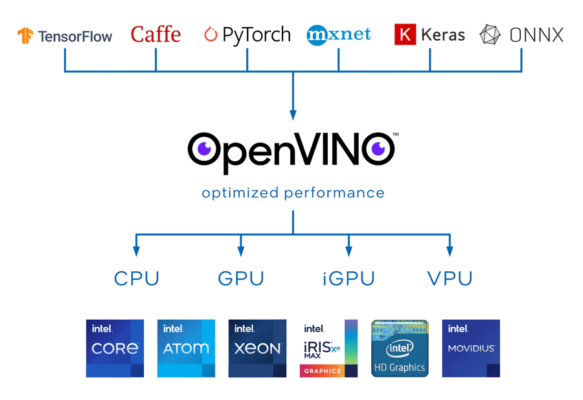AI Developers Innovate with Intel® OpenVINO™ 2022.1

Life just got a lot easier for AI developers with the latest release of the Intel® Distribution of OpenVINO™ Toolkit 2022.1—the most significant update since it launched in 2018. Packed with new features and capabilities, the new release is designed to tackle some of the most pressing artificial intelligence development challenges.
“OpenVINO 2022.1 builds on more than three years of learning from hundreds of thousands of developers to simplify and automate optimizations,” says Adam Burns, Vice President of OpenVINO Developer Tools in Intel’s Network and Edge Group. “The latest upgrade adds hardware auto-discovery and automatic optimization, so software developers can achieve optimal performance on every platform. This software plus Intel silicon enables a significant AI ROI advantage and is deployed easily into the Intel-based solutions in your network.”
What’s new with the Intel® Distribution of OpenVINO™ Toolkit
Tools like OpenVINO have become increasingly important over the past couple of years as organizations are under pressure to become better, smarter, and faster about the way they do things. AI has enabled them to digitally transform, gain deeper insights into their operations, and reduce manual effort.
But as a result, it’s changing the nature of developer work. For them to deal with the complexity of open architectures and ecosystems to work on a variety of supported devices, they need flexible, interoperable, and scalable tools.
“The idea is simplify, simplify, simplify, which allows the #developers to really focus on what they do best: innovate, create, and solve problems.” –@billpearson, @inteliot via @insightdottech
“The role of the developer becomes even more important than it’s been. We’ve got to make sure they’re equipped to deal with this new environment through tools, products, and the information that’s going to help them build their solutions that scale,” says Bill Pearson, Vice President of the Internet of Things Group at Intel.
OpenVINO 2022.1 aims to empower developers to create innovative AI-powered solutions. “The idea is simplify, simplify, simplify, which allows the developers to really focus on what they do best: innovate, create, and solve problems,” Pearson says. “AI is an opportunity for them to be able to go and embrace that new world and do some new things.”
The most notable features of the release include:
- OpenVINO API 2.0 makes it easier for developers to adopt and maintain code, switch between frameworks, and reduce complexity. Intel® recommends AI developers migrate to 2.0 API to take advantage of new capabilities such as working with dynamic shapes and adding preprocessing operations to inference models. The team plans to extend these features in the future. A guide on how to transition to the new API 2.0 is available here.
- Broader model support for natural language programming models, advanced computer vision, and PaddlePaddle models (Figure 1). Support for conversion and inference will be available for select PaddlePaddle models. The release also adds new pre-trained models with a new anomaly detection category and a focus on industrial inspection.
- Portability and performance updates, including an AUTO device model, auto-batching functionality, and support for 12th Gen Intel® Core™ hybrid architectures. The new AUTO plugin automatically discovers available systems and their inferencing capacity while automatic batching functionality scales batch size based on XPU and memory. Additionally, new performance hints are available to configure systems with portability in mind.

To learn more about all the changes in OpenVINO 2022.1, check out the full release notes.
The Intel® Distribution of OpenVINO™ Toolkit In Action
The increase of AI adoption is evident in almost every industry, with organizations beginning to optimize and deploy AI to solve challenges in ways you wouldn’t expect.
San Diego-based restaurant automation company Vistry is using OpenVINO in quick-serve restaurants to measure performance and detect areas where it can speed up and improve quality of service. And with a wide range of AI models available to them, restaurant operators have been able to optimize their kitchen production system and better understand customer journeys within the drive-through.
“Most restaurants don’t have these big beefy GPU servers sitting on-premises, so OpenVINO allows us to use these models in these low- powered environments and then still run in kind of real-time fashion, which may be critical in a lot of different restaurant applications,” says Gabriel Ibagon, Head of Engineering and Co-Founder for Vistry.
The AI toolkit can also be found in malls, helping operators make smarter decisions and boost performance. For instance, Pathr.ai, a real-time spatial intelligence company, uses OpenVINO to help physical retailers provide ecommerce-like experiences and analytics in-store at an affordable price. Its spatial intelligence platform gives retailers the tools to understand customer behavior in real time, how many customers are shopping at a given moment, and which products struggle on the shelf.
“Adopting Intel CPUs and the Intel® Distribution of OpenVINO™ toolkit accelerated Pathr.ai’s deployment in multistory shopping centers in near-real time, allowing us to scale our solution across existing infrastructure and deliver cost and power savings to our client in a GDPR-compliant way,” says George Shaw, Founder and CEO of Pathr.ai.
As AI use cases and new ways to implement AI continue to expand into unexpected areas, all the new capabilities of OpenVINO will be key to providing organizations a clear path to success. “This is a toolkit that just helps developers deliver faster and more accurate results using AI and computer vision inference,” says Pearson.
This article was edited by Georganne Benesch, Associate Editorial Director for insight.tech.